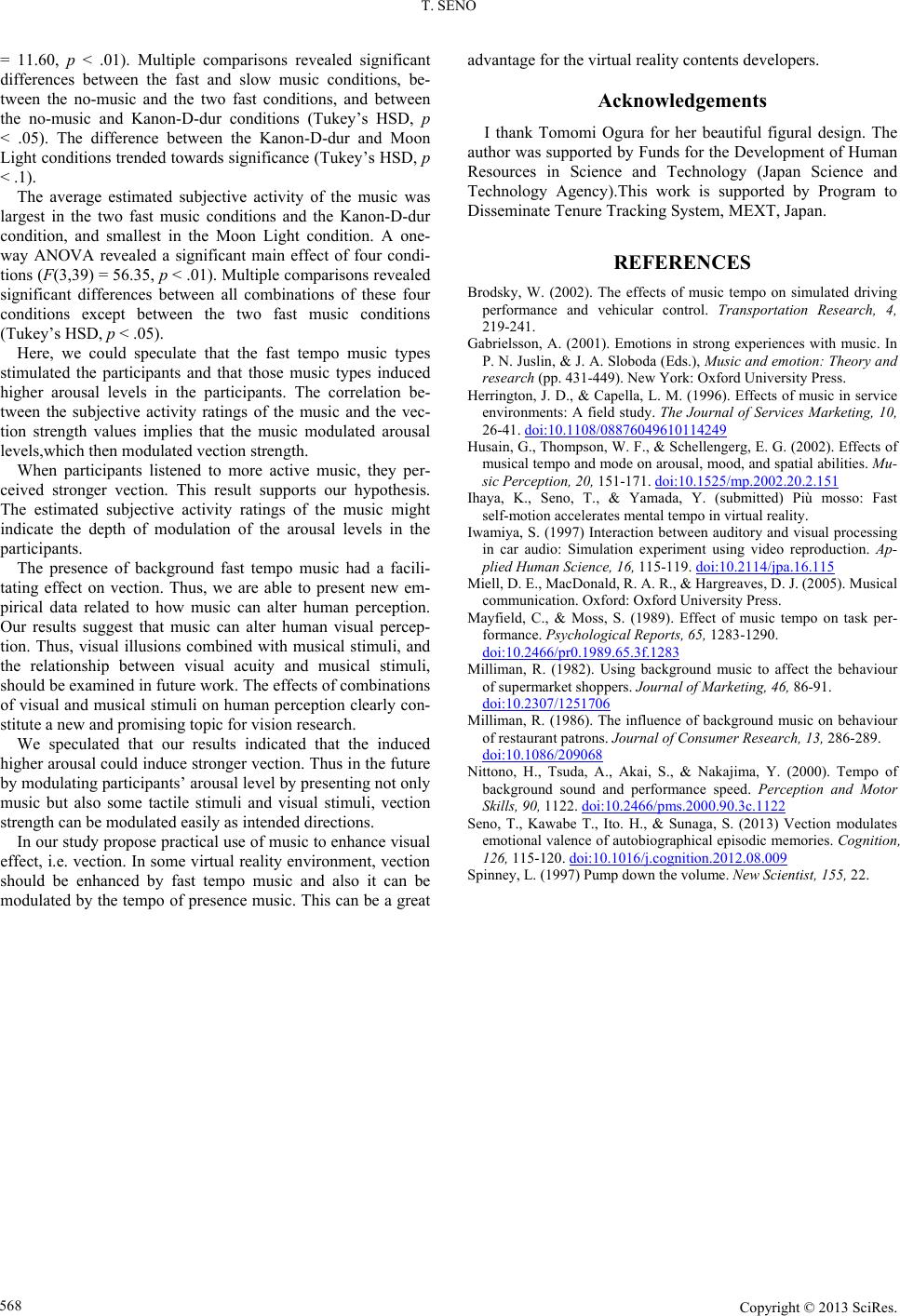
T. SENO
Copyright © 2013 SciRes.
568
= 11.60, p < .01). Multiple comparisons revealed significant
differences between the fast and slow music conditions, be-
tween the no-music and the two fast conditions, and between
the no-music and Kanon-D-dur conditions (Tukey’s HSD, p
< .05). The difference between the Kanon-D-dur and Moon
Light conditions trended towards significance (Tukey’s HSD, p
< .1).
The average estimated subjective activity of the music was
largest in the two fast music conditions and the Kanon-D-dur
condition, and smallest in the Moon Light condition. A one-
way ANOVA revealed a significant main effect of four condi-
tions (F(3,39) = 56.35, p < .01). Multiple comparisons revealed
significant differences between all combinations of these four
conditions except between the two fast music conditions
(Tukey’s HSD, p < .05).
Here, we could speculate that the fast tempo music types
stimulated the participants and that those music types induced
higher arousal levels in the participants. The correlation be-
tween the subjective activity ratings of the music and the vec-
tion strength values implies that the music modulated arousal
levels,which then modulated vection strength.
When participants listened to more active music, they per-
ceived stronger vection. This result supports our hypothesis.
The estimated subjective activity ratings of the music might
indicate the depth of modulation of the arousal levels in the
participants.
The presence of background fast tempo music had a facili-
tating effect on vection. Thus, we are able to present new em-
pirical data related to how music can alter human perception.
Our results suggest that music can alter human visual percep-
tion. Thus, visual illusions combined with musical stimuli, and
the relationship between visual acuity and musical stimuli,
should be examined in future work. The effects of combinations
of visual and musical stimuli on human perception clearly con-
stitute a new and promising topic for vision research.
We speculated that our results indicated that the induced
higher arousal could induce stronger vection. Thus in the future
by modulating participants’ arousal level by presenting not only
music but also some tactile stimuli and visual stimuli, vection
strength can be m o dulated easil y as intended directions.
In our study propose practical use of music to enhance visual
effect, i.e. vection. In some virtual reality environment, vection
should be enhanced by fast tempo music and also it can be
modulated by the tempo of presence music. This can be a great
advantage for the virtual reality contents developers.
Acknowledgements
I thank Tomomi Ogura for her beautiful figural design. The
author was supported by Funds for the Development of Human
Resources in Science and Technology (Japan Science and
Technology Agency).This work is supported by Program to
Disseminate Tenure Trac king System, MEXT, Japan.
REFERENCES
Brodsky, W. (2002). The effects of music tempo on simulated driving
performance and vehicular control. Transportation Research, 4,
219-241.
Gabrielsson, A. (2001). Emotions in strong experiences with music. In
P. N. Juslin, & J. A. Sloboda (Eds.), Music and emotion: Theory and
research (pp. 431- 449 ). New York: Oxford University Press.
Herrington, J. D., & Capella, L. M. (1996). Effects of music in service
environments: A field study. The Journal of Services Marketing, 10,
26-41. doi:10.1108/08876049610114249
Husain, G., Thompson, W. F., & Schellengerg, E. G. (2002). Effects of
musical tempo and mode on arousal, mood, and spatial abilities. Mu-
sic Perception, 20, 151-171. doi:10.1525/mp.2002.20.2.151
Ihaya, K., Seno, T., & Yamada, Y. (submitted) Più mosso: Fast
self-motion accelerates mental tempo i n virtual reality.
Iwamiya, S. (1997) Interaction between auditory and visual processing
in car audio: Simulation experiment using video reproduction. Ap-
plied Human Science, 16, 115-119. doi:10.2114/jpa.16.115
Miell, D. E., MacDonald, R. A. R., & Hargreaves, D. J. (2005) . Musical
communication. Oxford: Oxford University Press.
Mayfield, C., & Moss, S. (1989). Effect of music tempo on task per-
formance. Psychological Reports, 65, 1283-1290.
doi:10.2466/pr0.1989.65.3f.1283
Milliman, R. (1982). Using background music to affect the behaviour
of supermarket shoppers. Journal of Marketin g, 46, 86-91.
doi:10.2307/1251706
Milliman, R. (1986). The influence of background music on behaviour
of restaurant patrons. Journal of Consumer Research, 13, 286-289.
doi:10.1086/209068
Nittono, H., Tsuda, A., Akai, S., & Nakajima, Y. (2000). Tempo of
background sound and performance speed. Perception and Motor
Skills, 90, 1122. doi:10.2466/pms.2000.90.3c.1122
Seno, T., Kawabe T., Ito. H., & Sunaga, S. (2013) Vection modulates
emotional valence of autobiographical episodic memories. Cognition,
126, 115-120. doi:10.1016/j.cognition.2012.08.009
Spinney, L. (1997) Pump down the volume. New Scientist, 155, 22.